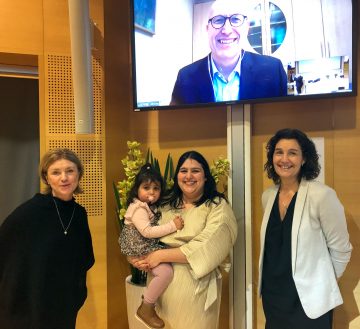
DOCTORAL EDUCATION. The first doctoral student admitted to doctoral studies at both Sahlgrenska Academy and KU Leuven has now defended her dissertation. In addition to a double doctoral degree for Mariela Acuna Mora, from the very start the collaboration provides her with both a solid doctoral education and access to an established international network of researchers.
Mariela Acuña Mora graduated as a nurse in her native Costa Rica. She came to Gothenburg to study an international master’s degree in public health and was recruited to the research group as a doctoral student upon finishing her master’s thesis. Her doctoral project has been part of the Stepstones research project, which studies the transition of young people with congenital heart defects and other chronic conditions from pediatric care to adult care and how these young people can be supported in gradually taking control of their health and life situation during a vulnerable period in life.

“Some people think that it sounds complicated to defend a dissertation with a double doctoral degree, but it is not at all as complicated as you might think. I have received an excellent doctoral education, where I was really able to grow as a researcher through the research collaboration outside of Sweden that I gained access to,” says Mariela Acuña Mora.
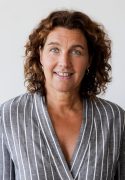
“Within nursing science, our disciplinary domain, there are few opportunities for doing an international postdoc. An advantage for doctoral students who receive a double doctoral degree is precisely to have access to an international research network, which offers a head start immediately after the dissertation,” adds Professor Carina Sparud Lundin, who is one of the supervisors for the dissertation project.
Scholarships funded all travel
During her doctoral studies, Mariela has been in Leuven for several periods, where the trips were completely funded by several different scholarships.
“This has resulted in interesting collaborations with colleagues in Belgium. During my time in Leuven, I have been able to focus a lot on writing and had the opportunity to take doctoral courses that in Sweden can be difficult to get a spot in or that are not given here at all,” she says.
Sweden has many good travel scholarships for young researchers to apply for, which provide opportunities for international experience during the doctoral program,” says Philip Moons.
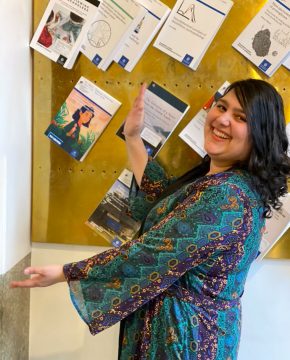
The Stepstones project is being conducted in collaboration with researchers at the Institute of Health and Care Sciences and the Belgian university KU Leuven, in particular through collaboration with Professor Philip Moons, who proposed that the collaboration be cemented through a joint doctoral student.
Joint doctoral students cement collaboration
Philip Moons was previously a visiting professor at the Institute of Health and Care Sciences and now has a part-time position as a researcher at the University of Gothenburg to enable continued collaboration. KU Leuven already had previous experience of joint doctoral students with other higher education institutions, and Philip believes that there are only advantages and opportunities with double degree doctoral students.
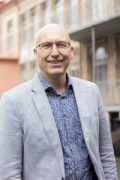
“I want to say that it is a win-win-win-win for everyone involved: for the doctoral student, for the supervisors, for the universities and for the project where the research is being done. This approach means the universities have to agree on what standards apply for doctoral studies and also what requirements apply for the collaboration as a whole, and this makes it easy to travel and collaborate with the other university.”
This first joint doctoral student project has been followed by several more – the Institute of Health and Care Sciences currently has four more ongoing joint doctoral students with KU Leuven.
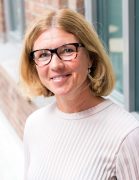
“Mariela’s doctoral project has entrenched this successful collaboration between KU Leuven and the University of Gothenburg. We have learned a lot about our similarities but also about our differences. It has broadened our perspectives and added interesting aspects to our research discussions,” says Associate Professor Ewa-Lena Bratt, who is also the principal supervisor at the University of Gothenburg for the dissertation project.
Ewa-Lena Bratt and Carina Sparud Lundin, who led implementation of the joint double degree doctoral project, receives a lot of curious questions from colleagues at the institute on how they planned and organized the studies. They eagerly recommend others establish joint doctoral projects with partners at other universities and are happy to answer questions.
Defending a dissertation during the pandemic
The pandemic stopped the last planned trip to Belgium this last October, and also required that the dissertation defense be adapted. Mariela Acuña Mora defended her thesis on Friday January 15 with a small number of people present in the Arvid Carlsson lecture hall at Medicinareberget, the external reviewer, Professor Deborah Christie, attending via Zoom from London and a live broadcast by link to KU Leuven in Belgium.
“When I started my doctorate, I imagined that my whole family, my friends and colleagues would attend the defense. That wasn’t to be, but that’s okay. Somehow I think that the scaled-down defense may have reduced the level of stress somewhat, and I still feel it was a special and solemn occasion,” says Mariela Acuña Mora, who, after her dissertation, will now combine teaching and researching at the University of Borås and at the Institute of Health and Care Sciences at the University of Gothenburg.
Second double doctoral student to defend her thesis
Previously, Egbert Clevers had defended his dissertation with a double doctoral degree at the two universities in a research collaboration on IBS, but Mariela Acuña Mora was the first to be admitted to the doctoral program specifically with this approach and the first to defend her thesis at the Sahlgrenska Academy with the University of Gothenburg as the main university.
Mariela Acuña Mora’s dissertation is entitled Patient empowerment during the transition to adulthood in young persons with chronic conditions;https://gupea.ub.gu.se/handle/2077/65151
TEXT: ELIN LINDSTRÖM










